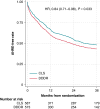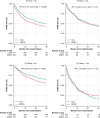Closed loop stimulation reduces the incidence of atrial high-rate episodes compared with conventional rate-adaptive pacing in patients with sinus node dysfunctions
- PMID: 38938169
- PMCID: PMC11226787
- DOI: 10.1093/europace/euae175
Closed loop stimulation reduces the incidence of atrial high-rate episodes compared with conventional rate-adaptive pacing in patients with sinus node dysfunctions
Erratum in
-
Correction to: Closed loop stimulation reduces the incidence of atrial high-rate episodes compared with conventional rate-adaptive pacing in patients with sinus node dysfunctions.Europace. 2024 Aug 3;26(8):euae217. doi: 10.1093/europace/euae217. Europace. 2024. PMID: 39186701 Free PMC article. No abstract available.
Abstract
Aims: Subclinical atrial fibrillation (AF) is associated with increased risk of progression to clinical AF, stroke, and cardiovascular death. We hypothesized that in pacemaker patients requiring dual-chamber rate-adaptive (DDDR) pacing, closed loop stimulation (CLS) integrated into the circulatory control system through intra-cardiac impedance monitoring would reduce the occurrence of atrial high-rate episodes (AHREs) compared with conventional DDDR pacing.
Methods and results: Patients with sinus node dysfunctions (SNDs) and an implanted pacemaker or defibrillator were randomly allocated to dual-chamber CLS (n = 612) or accelerometer-based DDDR pacing (n = 598) and followed for 3 years. The primary endpoint was time to the composite endpoint of the first AHRE lasting ≥6 min, stroke, or transient ischaemic attack (TIA). All AHREs were independently adjudicated using intra-cardiac electrograms. The incidence of the primary endpoint was lower in the CLS arm (50.6%) than in the DDDR arm (55.7%), primarily due to the reduction in AHREs lasting between 6 h and 7 days. Unadjusted site-stratified hazard ratio (HR) for CLS vs. DDDR was 0.84 [95% confidence interval (CI), 0.72-0.99; P = 0.035]. After adjusting for CHA2DS2-VASc score, the HR remained 0.84 (95% CI, 0.71-0.99; P = 0.033). In subgroup analyses of AHRE incidence, the incremental benefit of CLS was greatest in patients without atrioventricular block (HR, 0.77; P = 0.008) and in patients without AF history (HR, 0.73; P = 0.009). The contribution of stroke/TIA to the primary endpoint (1.3%) was low and not statistically different between study arms.
Conclusion: Dual-chamber CLS in patients with SND is associated with a significantly lower AHRE incidence than conventional DDDR pacing.
Keywords: Accelerometer pacemaker sensor; Atrial fibrillation; Atrial high-rate episodes; Closed loop stimulation; Rate-adaptive pacing; Stroke.
© The Author(s) 2024. Published by Oxford University Press on behalf of the European Society of Cardiology.
Conflict of interest statement
Conflict of interest: G.L.B. received speaker’s fee from Abbott, Biotronik, Boston Scientific, Medtronic, and MicroPort. M.D.M., D.G., and A.G. are employees of Biotronik Italia S.p.A., an affiliate of Biotronik SE & Co. KG (study sponsor and manufacturer of investigational devices). All remaining authors have declared no conflicts of interest.
Figures






References
-
- Healey JS, Connolly SJ, Gold MR, Israel CW, van Gelder IC, Capucci Aet al. . Subclinical atrial fibrillation and the risk of stroke. N Engl J Med 2012;366:120–9. - PubMed
-
- Kirchhof P, Toennis T, Goette A, Camm AJ, Diener HC, Becher Net al. . Anticoagulation with edoxaban in patients with atrial high-rate episodes. N Engl J Med 2023;389:1167–79. - PubMed
-
- Healey JS, Lopes RD, Granger CB, Alings M, Rivard L, McIntyre WFet al. . Apixaban for stroke prevention in subclinical atrial fibrillation. N Engl J Med 2024;390:107–17. - PubMed
-
- Gonzalez M, Keating RJ, Markowitz SM, Liu CF, Thomas G, Ip JEet al. . Newly detected atrial high rate episodes predict long-term mortality outcomes in patients with permanent pacemakers. Heart Rhythm 2014;11:2214–21. - PubMed
-
- Jiang J, Mi L, Chen K, Hua W, Su Y, Xu Wet al. . Association of device-detected atrial high-rate episodes with long-term cardiovascular and all-cause mortality: a cohort study. Can J Cardiol 2024;40:598–607. - PubMed
Publication types
MeSH terms
Grants and funding
LinkOut - more resources
Full Text Sources
Medical

